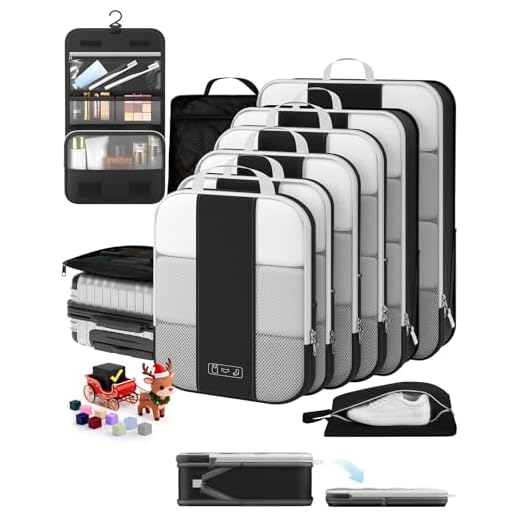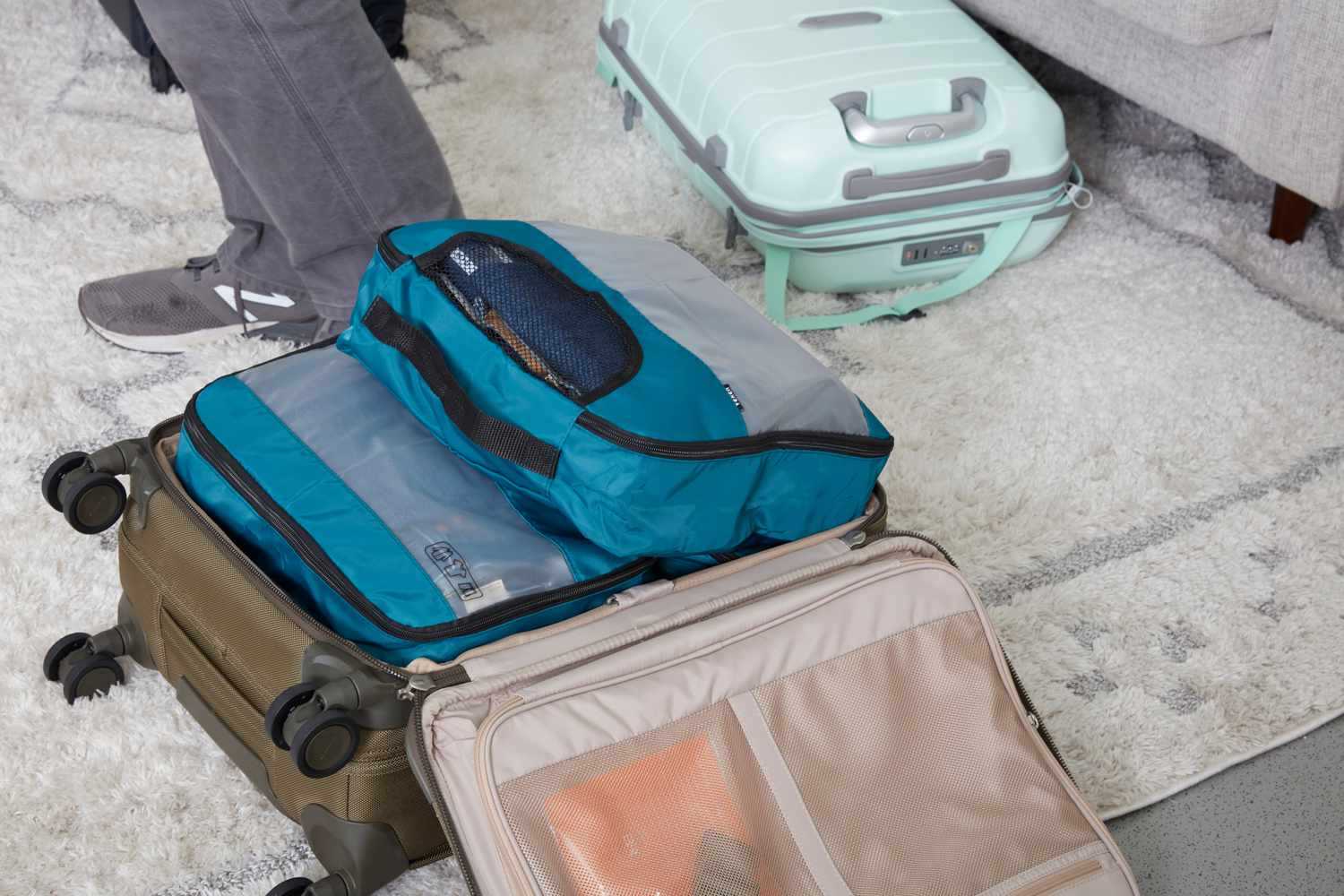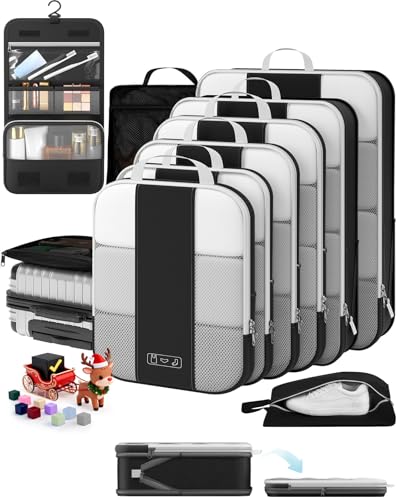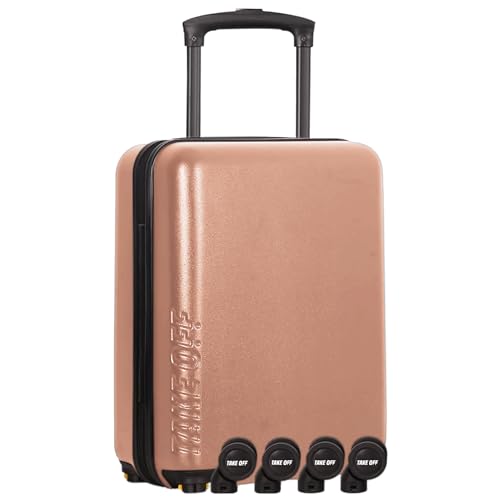




Using packing cubes can significantly maximize space and organization in your suitcase. This article focuses on various methods to streamline your travel preparation, making it easier to find what you need without the hassle of rummaging through disorganized items.
Travelers of all types–whether you’re a weekend adventurer or a frequent flyer–will find these strategies beneficial. The techniques discussed will help you pack smarter, ensuring you can fit all necessary belongings while minimizing stress during your trips.
We will explore the advantages of compartmentalizing your items, choosing versatile clothing, and utilizing compression bags. Additionally, the article offers tips on planning outfits and selecting the right bag for different types of travel, ensuring that you are always ready for any adventure that comes your way.
Best Luggage Packing System
Utilizing a methodical approach to organizing your gear can significantly enhance travel experiences. Begin by categorizing items based on their type and purpose, which allows for easy access and minimizes frustration during your trip.
Utilizing packing cubes is one effective strategy. These compartments help to keep clothes, toiletries, and accessories separated, maximizing available space. Consider rolling clothing instead of folding; this technique reduces wrinkles and makes it easier to fit items together.
Key Techniques for Efficient Organization
- Layering: Place heavier items at the bottom and lighter ones on top. This ensures stability and prevents crushing delicate items.
- Utilize every inch: Fill shoes with socks or small items to save space.
- Compression bags: These can minimize the volume of bulky clothing, providing additional room for other essentials.
Consider the use of a checklist to avoid forgetting vital items. Create a list tailored to the specific trip, ensuring all necessary items are included.
| Item Category | Example Items |
|---|---|
| Clothing | Shirts, pants, undergarments |
| Toiletries | Shampoo, toothbrush, skincare |
| Electronics | Chargers, headphones, travel adapters |
Lastly, keep important documents and valuables in an easily accessible compartment. This ensures security and convenience during your travels.
Choosing the Right Suitcase for Efficient Packing
Select a suitcase that fits your travel style and needs. Consider the size, weight, and features of the case to optimize the amount of items you can carry. A well-chosen suitcase not only accommodates your belongings but also provides ease during transit.
Hard-shell variants offer protection for fragile items, while soft-shell designs tend to be lighter and more flexible. Assess your preferences based on the duration and nature of your trip to determine which type aligns with your requirements.
Key Features to Consider
- Size: Ensure the dimensions comply with airline regulations for carry-ons or check-ins.
- Weight: Lighter options allow for more packed items without exceeding weight limits.
- Wheels: Four-wheeled models provide better maneuverability in crowded areas.
- Handles: Look for sturdy, ergonomic handles for comfortable lifting and pulling.
- Pockets: External and internal compartments aid in organization and quick access to essentials.
Additionally, consider the material. Durable fabrics or polycarbonate shells can withstand wear and tear, while water-resistant options protect your belongings from unexpected weather. A suitcase with a locking mechanism enhances security and peace of mind.
Prioritize features that cater to your personal packing style. If you often carry electronics, ensure there are padded compartments. For frequent travelers, a suitcase with a built-in charging port can be a significant advantage.
Ultimately, the right suitcase simplifies the travel process. Invest time in evaluating your options to find a case that complements your packing strategies and enhances your travel experience.
Essential Packing Cubes: Maximizing Space and Organization
Utilizing packing cubes can significantly enhance the way items are stored and organized within your travel bag. These fabric containers help compartmentalize belongings, ensuring that everything has a designated space. This method not only maximizes available space but also simplifies access to essentials during your trip.
When selecting cubes, focus on various sizes to suit different types of clothing and accessories. Smaller cubes can be ideal for undergarments and accessories, while larger ones accommodate bulkier items like jackets and shoes. This strategic arrangement helps in maintaining a tidy and organized travel experience.
Benefits of Using Packing Cubes
- Space Optimization: Compress clothes and maximize packing volume, allowing for more items to fit in the same space.
- Easy Organization: Keep similar items together, making it easier to find what you need without rummaging through your entire bag.
- Wrinkle Reduction: Properly packed garments are less likely to wrinkle, arriving at your destination in better condition.
- Efficient Unpacking: Simply pull out a cube and place it in a drawer or on a shelf, streamlining the unpacking process.
Consider incorporating a color-coding system for added efficiency. Assign specific colors to different categories, such as clothing, toiletries, or electronics. This visual aid simplifies the identification of contents at a glance.
In summary, incorporating packing cubes into your travel preparations can transform the way items are organized and accessed. By maximizing space and improving the overall organization of your bag, you create a more enjoyable and stress-free travel experience.
Roll vs. Fold: Techniques for Optimal Clothing Arrangement
Rolling clothes is often more space-efficient than folding, allowing for better organization within your travel container. This technique helps to minimize wrinkles and makes it easier to access specific items without disturbing the entire arrangement.
Folding, however, can be beneficial for structured garments such as blazers and dress shirts, ensuring they maintain their shape. This method also provides a clear view of your clothing selection, facilitating quick decisions during your travels.
Comparative Techniques
Both rolling and folding have their merits. Here’s a breakdown of their advantages:
- Rolling:
- Reduces wrinkles for many fabrics.
- Maximizes space by allowing for tighter arrangements.
- Enables quick visibility of items when stacked.
- Folding:
- Best for structured clothing to maintain shape.
- Facilitates organization by category or outfit.
- Reduces the risk of damage to delicate fabrics.
To determine the best approach, consider the type of garments you are packing:
- Casual wear: Rolling is typically more effective for t-shirts and casual dresses.
- Formal attire: Fold dress shirts and blazers to keep them crisp.
- Layering: Mix both techniques by rolling lighter items and folding heavier ones for balance.
Experiment with both methods to find the combination that works best for your needs. Assessing the types of clothing and their intended use will guide your choice, ensuring a well-organized and practical arrangement.
Utilizing Compression Bags for Extra Storage
Compression bags are an excellent solution for maximizing available space in your travel gear. By utilizing these bags, you can significantly reduce the volume of clothing and other soft items, allowing for more efficient organization. This method is particularly useful for bulky items such as jackets, sweaters, and bedding.
To make the most of compression bags, follow these steps:
- Choose the Right Size: Select bags that fit your items. Smaller bags work well for individual garments, while larger ones can accommodate multiple items.
- Pack Strategically: Roll or fold clothes neatly before placing them in the bags. This helps to maximize the compression effect.
- Seal and Compress: After packing, seal the bags and use a vacuum or manually squeeze out excess air. This process reduces volume significantly.
- Organize by Category: Group similar items together (e.g., all shirts in one bag) for easy access during your travels.
Using compression bags not only saves space but also keeps items protected from moisture and dirt. They are particularly advantageous for long trips or when traveling to multiple destinations. Incorporating this method into your traveling routine can lead to a more organized and enjoyable experience.
Smart Accessories to Enhance Your Packing Strategy
Utilizing compression bags can significantly save space in your suitcase. These bags allow you to reduce the bulk of clothing by removing air, making it easier to fit more items without increasing the size of your bag. They are particularly useful for bulkier garments like jackets and sweaters.
Another valuable tool is packing cubes. These help in organizing your belongings by categories, such as clothing, toiletries, and electronics. By separating items, you can quickly locate what you need without rummaging through your entire bag.
Additional Accessories to Consider
- Travel-sized containers: Perfect for minimizing the space taken by liquids and toiletries.
- Multi-purpose travel pouches: Useful for keeping small items together and easily accessible.
- Tech organizers: Ideal for keeping chargers, cables, and gadgets neatly arranged.
- Portable luggage scale: Prevents surprises at the airport by allowing you to weigh your bag beforehand.
Incorporating these smart accessories into your travel routine not only enhances organization but also streamlines your experience, making your trip more enjoyable.
Creating a Personal Packing Checklist for Every Trip
Begin by identifying the key items you require for different types of travel. Consider the duration, destination, and activities planned. For instance, a weekend getaway will have different needs than a two-week international excursion.
Organize your checklist into categories for better clarity. Common sections include clothing, toiletries, electronics, documents, and miscellaneous items. This structure helps ensure nothing is overlooked.
Checklist Categories
- Clothing:
- Weather-appropriate attire
- Footwear suitable for activities
- Accessories like hats and scarves
- Toiletries:
- Personal hygiene items
- Medications and vitamins
- Travel-sized products
- Electronics:
- Chargers and adapters
- Camera or other devices
- Headphones
- Documents:
- Passport and identification
- Travel itinerary and reservations
- Insurance details
- Miscellaneous:
- Reusable water bottle
- Snacks for travel
- Books or entertainment
Regularly update your checklist based on past trips and experiences. This practice allows for continuous improvement and ensures you are prepared for future adventures.
Consider using a digital format for easy access and modification. Apps and cloud storage can help keep your list handy, allowing for quick adjustments as needed.
Tips for Toiletries and Miscellaneous Items
Use travel-sized containers for liquids, gels, and creams to save space and comply with security regulations. Consider purchasing reusable silicone pouches to keep toiletries organized and prevent leaks.
Group similar items together in small pouches or ziplock bags. This makes it easier to find what you need without rummaging through your belongings.
Organization Strategies
- Toiletry Bag: Invest in a compact, waterproof toiletry bag with multiple compartments.
- Labeling: Use labels on your pouches to quickly identify contents.
- Multi-use Products: Choose products that serve multiple purposes, such as a moisturizer with SPF.
For miscellaneous items, consider the following:
- First Aid Kit: Include band-aids, pain relievers, and any personal medications.
- Chargers and Cables: Use a small pouch to keep all electronic accessories organized.
- Snacks: Pack lightweight, non-perishable snacks to avoid hunger during travel.
Incorporating these strategies will lead to a well-organized travel experience, allowing for quick access to your personal care items while minimizing the bulk in your bags.
Best luggage packing system
Features
| Model | PCC7V101 |
| Color | Black |
| Size | 10 set |
Features
| Part Number | X7-5G |
| Model | X7-5G |
| Color | Grey and white |
| Release Date | 2025-03-10T07:00:00.000Z |
| Size | 15 Combo Travel Size |
Video:
FAQ:
What are some effective methods for packing luggage efficiently?
There are several methods to pack luggage efficiently. One popular technique is the rolling method, where clothes are rolled tightly to minimize wrinkles and maximize space. Another method involves using packing cubes, which help organize items and keep them compact. Additionally, utilizing every available space, such as stuffing shoes with socks or using the gaps in your suitcase, can help you fit more items. Lastly, making a packing list in advance can ensure you only bring what you need, preventing overpacking.
How can I maximize space in my suitcase without compromising on what to bring?
To maximize space in your suitcase, start by selecting versatile clothing items that can be mixed and matched. Use packing cubes to categorize your belongings, which not only saves space but also makes it easier to find items. Consider compression bags for bulky items like jackets or sweaters, as they reduce the volume significantly. Additionally, prioritize lightweight fabrics and avoid packing items that you can easily buy at your destination, such as toiletries. This approach allows you to bring everything you need while keeping your luggage manageable.
Are there any specific packing hacks for different types of trips, like business or leisure travel?
Yes, there are packing hacks tailored for various trip types. For business travel, choose wrinkle-resistant clothing and pack a portable steamer to ensure you look polished at meetings. Use a garment bag or fold dress clothes carefully to prevent creasing. For leisure travel, prioritize comfort and versatility in your clothing choices. Packing a lightweight backpack as a day bag can also be helpful for excursions. Regardless of the trip type, always pack a reusable water bottle and snacks to stay energized on the go.
What should I consider while packing for international travel?
When packing for international travel, consider the climate and culture of your destination. Research local customs to ensure your clothing is appropriate. It’s also wise to pack a universal travel adapter for electronics. Keep essential items like travel documents, medications, and a change of clothes in your carry-on bag, as this ensures they are accessible during your journey. Additionally, be aware of baggage restrictions and weight limits imposed by airlines to avoid extra fees. Finally, consider purchasing travel insurance for peace of mind while abroad.







